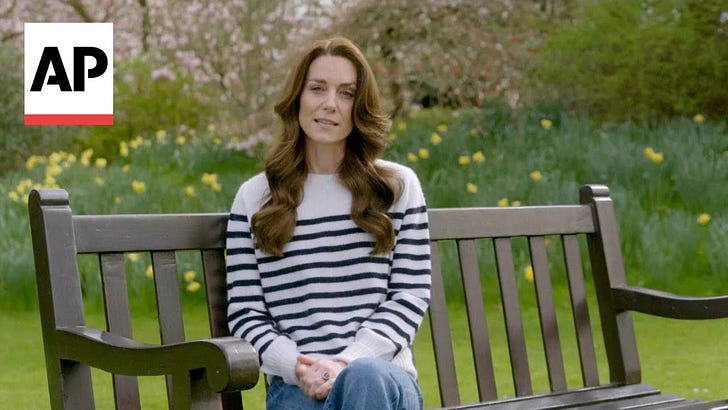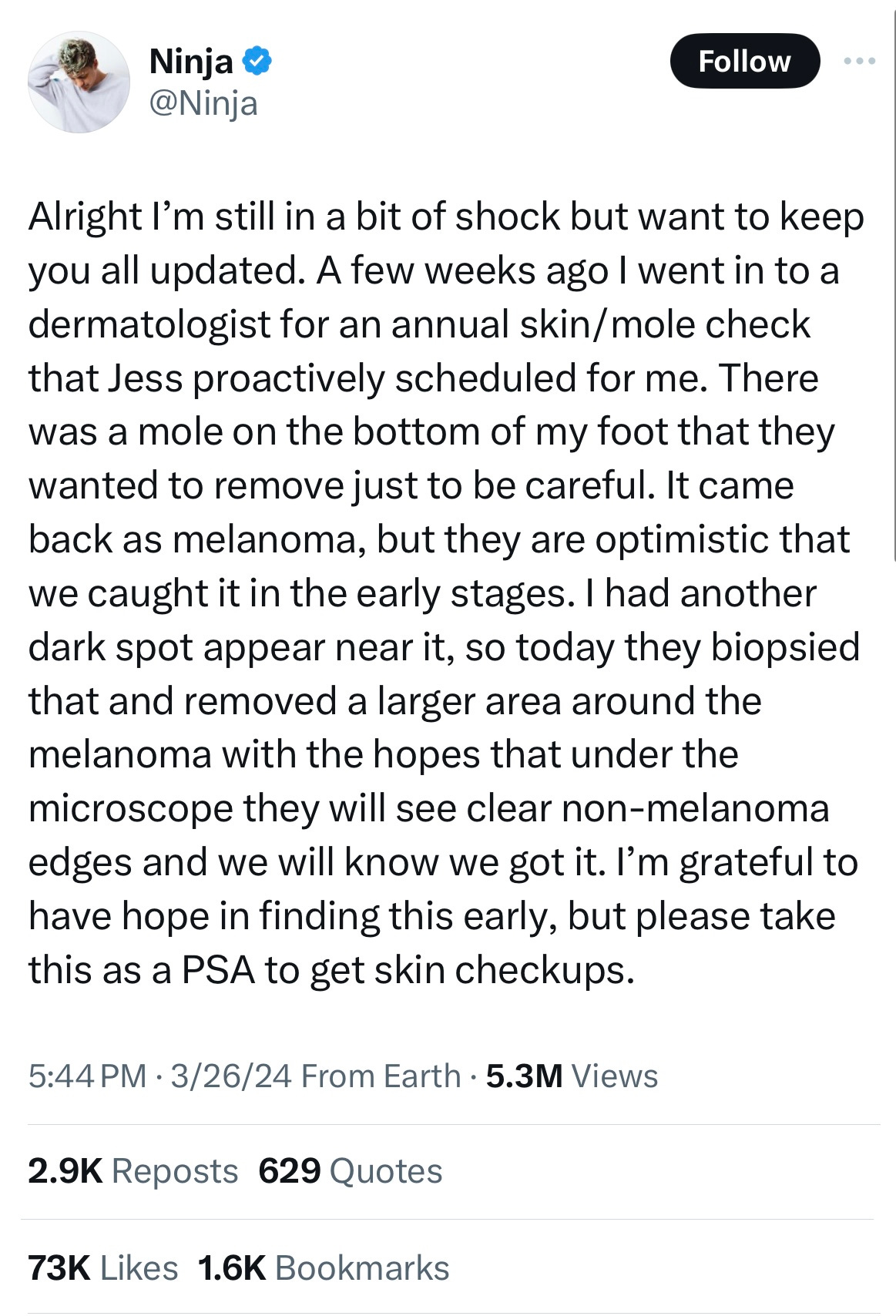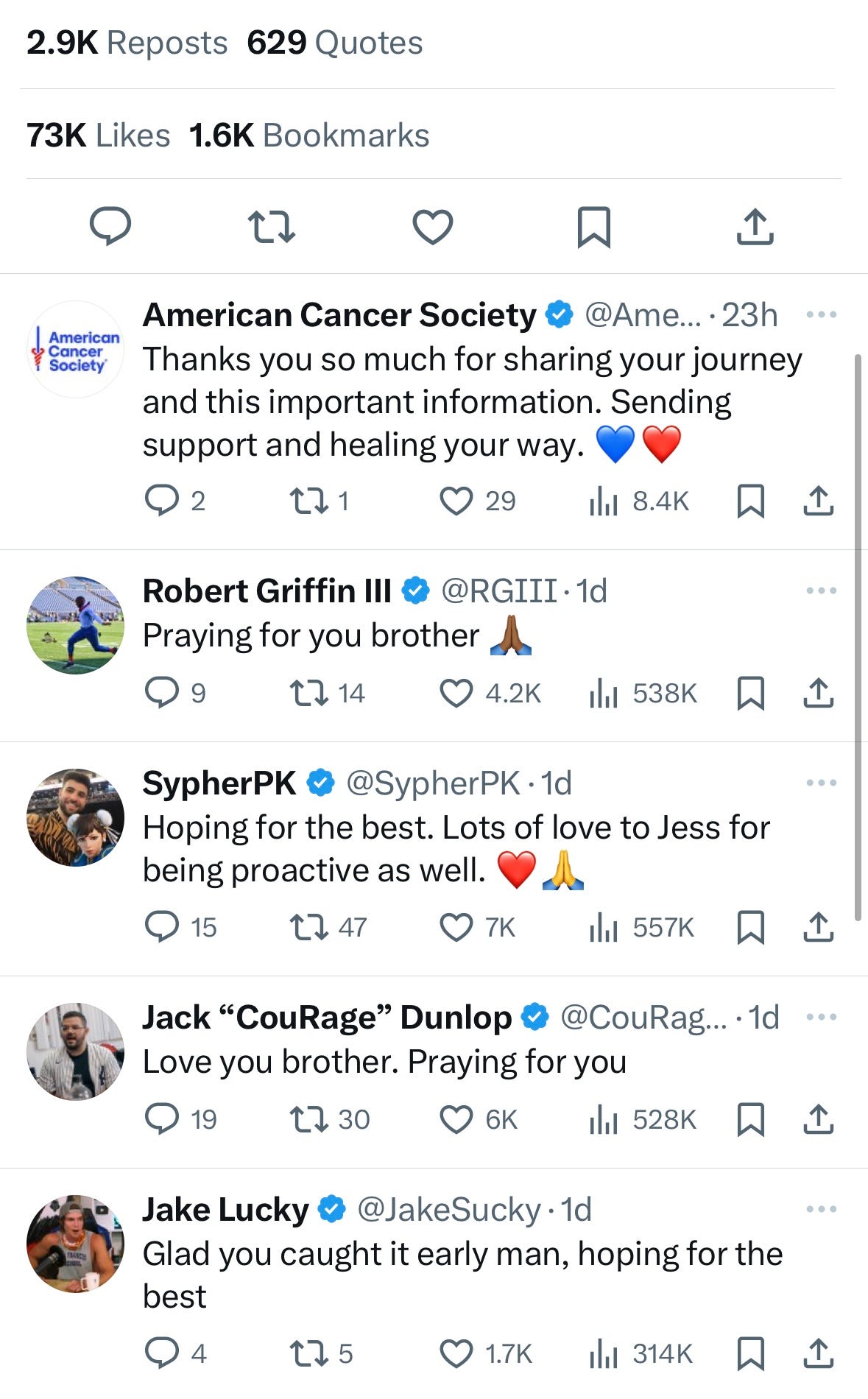A ninja, beauty influencer, and princess in the news
How celebrity cancer disclosures shape public discourse and private behavior
Unless you live under a rock (everyone knows there is bad cell phone service under rocks), you likely heard that Kate Middleton (Catherine, Princess of Wales) released a video last week revealing she has cancer.
This is not a post about conspiracy theories and public relations malpractice. I did speak with NBC News last week about the psychology of sharing memes when famous rich people are sick. But I want to focus here on the public health ramifications of all these news coverage of the princess’ cancer disclosure.
What type of cancer is it?
Kate’s video did not disclose the type of cancer she has. While people have speculated (some with more or less credibility), we likely will not ever know unless she decides to tell us at some later point. In February, Buckingham Palace announced that King Charles III had cancer, but would not say what type other than to insist it was not prostate cancer. To us, this seems vague, but media accounts have historically contextualized the fact that previous royals, including his own mother and grandfather, were unlikely to ever admit to an illness, including cancer.
Regardless of this comparative “forthrightness,” the people watching Kate’s video, reading news stories about it, seeing social media posts and memes with further commentary on her diagnosis and delay in disclosing it, live in the present day. Keeping quiet about the type of cancer implies that certain types are less socially acceptable than others.
After Alan Rickman and David Bowie both died of cancer in January of 2016, I conducted a study examining how the type of cancer affecting a celebrity can influence public responses to it. I experimentally manipulated an obituary that participants read (one for each celebrity). A third of the participants read the cause was the generic “cancer,” another third read it was liver cancer, and another third read that it was lung cancer. I found that lung cancer sparked greater feelings of sadness and anxiety, which translated into stronger perceptions that the cancer was the celebrity’s own fault, which then predicted lower intentions to do things like donate to cancer-related charities or sign a petition supporting greater funding for cancer research.
That study examined one particular context and one set of possible types of cancer, but the takeaway is that naming the type of cancer can, in fact, shape public emotions and downstream behaviors. Stigma related to cancer—particularly cancers of the reproductive organs—can have real harm in preventing people from acknowledging symptoms and/or seeking the type of care they need.
Kate does ask for privacy, and am not here to say she is wrong to do so. Likewise, some might believe King Charles is right to hold his specific diagnosis information tight. But, perhaps, they may want to keep in mind the positive impact they could have by specifying the type as well as the potential for increased stigma by not disclosing it, especially since their lifestyles are supported by British taxpayers.
We do not have princesses in the United States, but we do have First Ladies. In 1974, Betty Ford was diagnosed with breast cancer after a routine medical examination. At the time, it was taboo to say either cancer or breast. However, a woman who would break many health taboos, Betty insisted the diagnosis and her surgery be made public and the president agreed. The White House released photos of her recovering, including throwing a football President Ford got her as a gift. Afterward, there was a 15% increase in breast cancer diagnoses and she received more than 50,000 pieces of mail.
May Betty Ford’s legacy serve as a helpful prompt to the Royals across the pond.
I did find that one particular piece of Kate’s video sparked a great deal of curiosity and public education around cancer treatment, though. Her mention of “preventative chemotherapy” introduced a phrase many people were unfamiliar with and although it implies prevention, this is not the typical, or “primary,” type of prevention most of us think of. Primary prevention aims to stop a disease before it starts.
Instead, preventative chemotherapy is a form of secondary prevention that uses chemotherapy to, hopefully, catch microscopic traces of cancer that were not detectable during the surgery. Morning commonly known as adjuvant therapy in the US, and as this piece in USA Today notes, it is commonly used in cases of colon, breast, and lung cancer (it has also been applied to other types of cancer, too).
Kate’s privilege
Two days before the Princess of Wales released her video testimonial, news broke about a popular beauty influencer, Jessica Pettway, age 36, dying of cervical cancer. She became famous for her YouTube tutorials about hair and make-up and amassed a large following of fans across multiple social media platforms.
On July 31 of 2023, she took to Instagram to disclose her diagnosis with Stage 3 cervical cancer. But what was so disheartening about the post was how her pain and intense bleeding (so bad she had passed out) were initially misdiagnosed as fibroids. It took seven months for her to be referred to an oncologist. It is not a coincidence that Jessica Pettway is black and was diagnosed later in the course of her disease. As summarized by researchers in the American Journal of Preventive Medicine,
Black women 30% more likely to develop and 60% more likely to die from cervical cancer than non-Hispanic White women. Hispanic women have a 51% higher age-adjusted incidence of cervical cancer than non-Hispanic White women.
Joel Bervell, a medical student and myth-buster on TikTok, gives an excellent summary of the medical racism involved in missed and late diagnoses. Bervell also discusses the importance of HPV vaccines in helping to prevent cervical cancer. When celebrity disclosures and deaths are discussed in the news, it is helpful to make sure audiences know of any specific actions they can take to prevent the health threat for themselves.

 Tiktok failed to load.
Tiktok failed to load.Enable 3rd party cookies or use another browser
In fact, the lack of a specific diagnosis for Kate (or Charles) makes it impossible for news reports to integrate prevention education into their coverage of the royals. When diseases are vague, causes and potential preventive steps are vague. And one of the primary tenants of health communication is that audiences are more likely to act with the call to action is specific.
Kate also notes in her video that she was fortunate to be able to get good healthcare. We can remind ourselves that not everyone is as lucky as a princess and we can consider ways to keep improving that situation.
Research also shows that Black doctors are more likely to take better care of their Black patients. While members of the US House of Representatives push legislation to end diversity, equity, and inclusion efforts in medical schools, the evidence suggests that will only hurt individual and public health. Kudos to the news organizations engaging with Black doctors on the topic of cervical cancer in light of Jessica Pettway’s passing.
What is Twitch and who is Ninja?
Celebrity cancer diagnoses can have a big impact on some people and almost no impact on others, depending on how psychologically attached one is to the media figure. This week, while many people were talking about Kate and Jessica, others were talking about Ninja.
Ninja (otherwise known as Richard Tyler Blevins) is a 32-year-old gamer famous for his channel on Twitch, a live-streaming platform owned by Amazon. Tuesday, he announced on Twitter/X that had a case of melanoma removed from his foot. As of Wednesday, the post had been seen by more than 5 million people. More than 18 million people watch Ninja play video games, like Fortnite and Halo, on Twitch.
The foot is not an uncommon place for melanoma, even though it may not get as much sun as other body parts. It is important to note that anyone of any race can get melanoma on their feet. As the American Academy of Dermatology states, “about the same number of African Americans and Caucasians develop melanoma on a foot. For people of African or Asian ethnicity, the feet and hands are the most common places for melanoma to appear.”
Ninja’s post about his diagnosis and surgeries received support from the American Cancer Society and other well-known individuals wishing him well and noting they were glad he caught it when he did. From a health communication standpoint, this is quite helpful as it can shift social norms towards paying attention to moles and to getting checked regularly.
Ninja is not the first male celebrity to discuss skin cancer as Hugh Jackman is regularly in the news for his various bouts with the disease. However, being younger and a gamer means that Ninja’s disclosure can bring awareness to and, hopefully, spark cancer conversations amongst a different demographic.
Ninja’s post also reminds us about the intersection of gender roles and health. His wife, Jessica Blevins, is the one who made him the dermatology appointment. She also posted on her social media feeds after his disclosure, helpfully pointing out that the average person may not recognize skin cancer (hence, it is important to see a dermatologist for annual skin checks).
Survey research suggests that a misconception that they are healthier than they are as well as fear of getting bad news lead many men to avoid going to the doctor. But piling on the emotional labor and time to women is not the answer for sustainable improvements to public health and skin cancer prevention.
De-gendering healthcare responsibilities will not be easy. As part of a large, international research team, we found that greater media use, particularly medical-focused media, increases perceptions that women are more susceptible than men to a number of diseases. More work is needed to tell stories about men and disease and hopefully remind men of the importance of taking pride in their own health.
Fitness icon Richard Simmons also recently disclosed he had a case of basal cell carcinoma that took three procedures to fully remove from his face. Unfortunately, many dermatologists’ offices have packed schedules with fewer doctors and more patients than ever. So, go ahead and schedule that skin check right now, even if it takes a while to get in, at least it will be on the books.
In sum
Celebrity cancer news is not just tabloid fodder. It means people are reading and talking about a topic that is often unpleasant to think about otherwise. Health communicators have a narrow window of time when cancer is in the public eye to make the most of it by discussion prevention and early detection strategies. None of these recent celebrity cancer stories exists in a vacuum, though. Issues of race, gender, and privilege permeate each one and remind us that there is more work to be done to use media to promote a healthier society.









This is a wonderful column; it contains so much useful information and good writing!
Fascinating…..thank you.